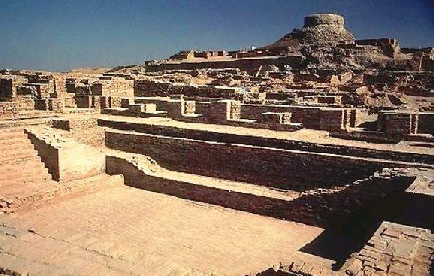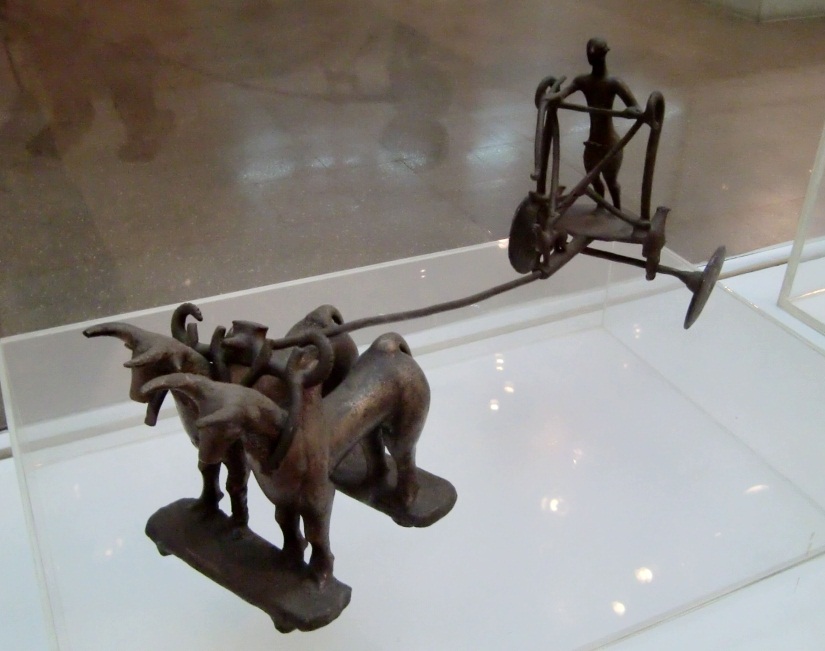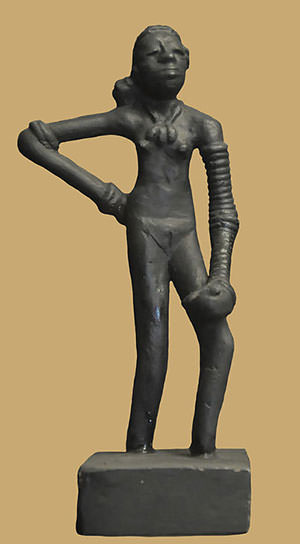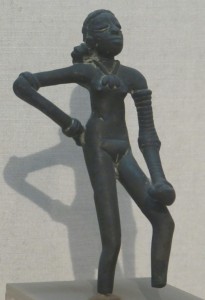INDUS VALLEY CIVILISATION




The Mesopotamia, Egypt, China and the Indus Valley Civilization, the four great civilizations of the ancient world, the first three (Mesopotamia, Egypt, and China) have been broadly studied and well-known to everyone. But the fourth and of equal importance, the much more sophisticated Indus Valley Civilization that flourished along the flood plains of Indus and Gaggar-Hakra is lost to human memory and till date remains puzzling.
It was in the 20th century, the lost and forgotten Indus Valley Civilization was rediscovered and acknowledged and given equal importance with the other three civilizations (Mesopotamia, Egypt, and China).
Here we bring some interesting facts about Indus Valley Civilization which would important for UPSC Civil Services IAS Prelims Exam.
Fact# 1: Indus Valley Civilization was the largest among the other four civilizations of the world (Mesopotamia, Egypt, and China)
- The Indus Valley Civilization was spread over an area of 1,260,000 sq. km over modern-India, Pakistan, and Afghanistan
- The civilization extended from Ghaggar-Hakra Valley in the east to Markran coast of Baluchistan in the west, from Afghanistan in the northeastern to Daimabad in Maharashtra in the south.

Fact# 2: The Population of Indus Valley Civilization was over 5 million
- The civilization had over 5 million inhabitants.
- Most of the inhabitants of the civilization were artisans and traders.
Fact# 3: Nearly 1056 cities have been discovered
- 1056 Harappan cities and settlements have been found
- of which 96 have been excavated
- Most of the settlements are mostly located in the broad region of the Indus and Ghaggar-Hakra Rivers and their tributaries.
- The major urban centers are: Harappa, Mohenjodaro, Dholaviral, Ganeriawala and Rakhigarhi.

Fact# 4: Majority of the population lived in villages and it is not evident
- Majority of the population of Indus Valley Civilization lived in villages
- it is not evident as the villages may have been constructed of destructible materials like mud or timber.
- Hence, it is difficult to find out the lifestyle and culture in these villages which have been lost over a period of time without any trace.
Fact# 5: Scholars and archaeologists are uncertain about the naming
- Since the first settlement was discovered along the banks of river Indus, the archaeologists named the civilization as Indus Valley Civilization. But on contrary only around 100 sites have been found in the Indus Valley, while over 500 sites are found along the Gaggar-Hakra River (The present day Saraswati River).
- Most of the archaeologists prefer to call them as ‘Indus-Saraswati Civilization’ based on the two river systems, while other prefer to name them as Harappan Civilisation as the first settlement was discovered in this city (Harappa).
And, according to some archaeologists, the sites along the Gaggar-Hakra River are preserved as they lie in the uninhabited desert.
Fact# 6: The Indus Valley Civilization could be the Meluhha mentioned by Mesopotamian scribes
- The Mesopotamian (Sumerian) scribes in the Middle Bronze Age refer frequently to a place they call Meluhha. Meluhha was a prominent trading partner of the Sumerians and they imported timber and ebony in high volumes.
- Sesame oil and luxury items like lapis lazuli were also imported from Meluhha, which was in all probability, the Indus Valley Civilization.

Fact# 7: Archaeologists first thought that they had stumbled upon cities of children
- When the cities of Harappa and Mohenjo-Daro were first discovered, a large number of toys including dice, whistles and marbles were found.
- This led the archaeologists to think that the majority of the inhabitants of those cities were children!
Fact# 8: The British used 4000-year old bricks from the Indus Valley Civilization to lay down 93 miles of railway track
- In 1856, when the British were building the East Indian Railway Company line from Karachi to Lahore, they faced a shortage of bricks.
- They took bricks from the nearby village of Harappa where they found bricks from a ‘ruined city’.
- These 4000-year old bricks were used for the railway track stretching to 93 miles (150 km).
Fact# 9: World’s first planned cities were found in the Indus Valley Civilization
- The cities of the civilization were planned in grid patterns with streets crossing at right angles.
- These marvels of urban planning were thousands of years older than the period of Hippodamus of Miletus, considered the ‘father of European urban planning’.

Fact# 10: The cities were not chaotic despite being densely populated
- The Indus Valley Civilization was a highly sophisticated civilization with a much organised way of living.
- Despite being densely populated, the cities were not chaotic, unlike contemporary cities of Mesopotamia or Egypt.
- Fact# 11: They had advanced sanitation systems
- People of the Indus Valley Civilization knew about and implemented channelling of water and the disposal of waste water way before any other ancient civilization did.
- Even the Romans built aqueducts thousands of years later.
Fact# 12: The largest city was Mohenjo-Daro- Mohenjo-Daro measuring an area of about 300 hectares was the largest city.
- Mohenjo-Daro might have had a 40000-strong population.
- Allahdino was the smallest site in the Indus Valley Civilization.
Fact# 13: The oldest Indus Valley settlement was established around 7000 B.C.- Mehrgarh is the oldest known settlement dating back to around 7000 B.C.
- It began during the Pre-Harappan period.
- Mehrgarh was a farming village.
Fact# 14: The cities and towns of the Indus Valley Civilization were standardised- Apart from being well-planned and having excellent drainage systems, the Harappan cities and towns were also standardised.
- Almost all the places excavated are seen as having a similar structure and pattern.
- Even the bricks of the houses had similar dimensions!
Fact# 15: Harappan towns had an interesting rectangular grid pattern - The Indus Valley cities and towns had a rectangular grid pattern.
- The main streets were along the North-South direction and the secondary streets were along the East-West direction.
- The streets intersected at right angles. This precise pattern is believed to be owing to religious or astronomical beliefs.
- Fact# 16: No congestion on the streets
- The streets found in Mohenjo-Daro and Harappa were as wide as 10.5 m.
- The smaller roads were at least 1.5 m wide.
- Archaeologists believe that the wide streets point out to market activities along them.
Fact# 17: The streets in Harappa were paved- Harappan streets were paved with burnt bricks to facilitate the easy movement of ox carts.
- The cities of the Indus Valley Civilization had channels running along the streets for the disposal of drainage water.
Fact# 18: There were distinct neighbourhoods in the cities- The cities of the Indus Valley Civilization could be divided into distinct neighbourhoods.
- Each neighbourhood had inhabitants who were engaged in a particular profession.
Fact# 19: The city of Mohenjo-Daro was built at least 9 times- Many of the cities of this civilization were destroyed several times by flood, deposition of silts, etc.
- Each time they were rebuilt.
- What is amazing is that every time they rebuilt the cities, they employed the same grid pattern.
- Mohenjo-Daro was constructed nine times and each time on top of the earlier grid.
- This shows the sophistication in their urban planning.
Fact# 20: Harappa had very advanced granaries- The granaries in Harappa used advanced technology that was seen in Rome 2800 years later.
- The sites also had citadels, bathing platforms and burial grounds.
 (The Great Bath at Mohenjo-Daro, Sindh, Pakistan)Fact# 21: The Indus Valley Civilization used standard burnt bricks everywhere
(The Great Bath at Mohenjo-Daro, Sindh, Pakistan)Fact# 21: The Indus Valley Civilization used standard burnt bricks everywhere- There were two types of bricks used in the Mature Harappa Period. One measured 7 X 14 X 28 cm and the other measured 10 X 20 X 40 cm in size.
- The bigger bricks were used to construct public buildings.
- The smaller bricks were used to build houses.
- Both types of bricks followed the 1:2:4 ratio.
Fact# 22: Ratio 1:2:4 all the way- The ratio 1:2:4 was not limited to bricks, but to all aspects.
- This ratio was followed in the houses, public structures, neighbourhood regions and even the city.
- Historians do not know whether this standardization was owing to religious beliefs or just a convention followed by the builders.
Fact# 23: Harappan houses were multi-storied buildings- So advanced was their architecture and masonry that Harappa had two and three-storied houses.
- These spacious houses had central courtyards and accessible flat terraces too.
Fact# 24: The Indus Valley houses could keep off dust and noise- None of the houses in the Indus Valley had windows facing the main streets.
- The houses had only one door.
- All the windows and the door of the houses would open into the central courtyard.
- Thus, they were strategically designed to avoid noise and dust.
Fact# 25: Houses with attached bathrooms- Indus Valley civilization was perhaps the first in the world to have houses with attached bathrooms.
- They also had access to running water.
- In addition, they had toilets with advanced drainage facilities.
Fact# 26: The world’s first rainwater harvesting was here- The Harappan civilization had systems to store rainwater.
- They had complex and efficient water management systems.
- The world’s public water tank, named The Great Bath was found here.
- The city of Mohenjo-Daro also had a large water management system with 80 public toilets and about 700 wells.
- The wells were strategically placed to supply water to every locality.
Fact# 27: Every city had its own Great Bath - Every city in the civilization had at least one Great Bath.
- It is believed that they might have had a religious purpose.
- Fact# 28: Hygiene was top priority
- The people of the Indus Valley Civilization led a very hygienic, clean and healthy life.
- The excavations reveal this fact.
- The large number of public baths, the excellent water management system, running water in every house, neat drainage systems and the underground wastewater systems all point out to the importance of hygiene in Harappan life.
Fact# 29: Dustbins along the streets- Even in those ancient times, the Indus Valley Civilization was way ahead of its time in terms of civic sense.
- There were dustbins placed along the streets in Mohenjo-Daro!
- These were brick containers especially for garbage disposal.
Fact# 30: Separate channels for stormwater and wastewater- So advanced was their water management system that they had separate channels lining the Harappan streets for wastewater and storm water (rainwater).
- The wastewater drains were underground, and had opening terracotta lids for cleaning purposes!
Fact# 31: Indus Valley had large-scale maritime trade relations with other civilizations- Many port-cities have been unearthed which proves the existence of large-scale maritime trade relations with other civilizations.
- Lothal could be the world’s first dockyard.
- Other ports include Allahdin, Suktagendor and Balakot.
Fact# 32: The Harappan cities had water-reservoirs- At the Harappan city of Dholavira, 16 water reservoirs have been found.
- These reservoirs serve the twin purposes of protecting the city from floods, and ensuring water supply throughout the year, even during dry season.
- They built dams that could control the flow of water and be stored in huge reservoirs.
Fact# 33: The Indus Valley Civilization was good in metallurgy

- They produced metal products including those in lead, copper, bronze and tin.
- They exported these products.
- They knew the technique of smelting copper with other metals.
- Gold necklaces smaller than 0.25 mm in diameter have been excavated at Lothal. Other metal artefacts have been found in Mohenjo-Daro, Harappa and Rangpur.
- Harappan copper implements were made by the method of casting.
- Bronze vessels were made from a single sheet which was hammered.
- Metal alloying technology was well-developed in the Indus Valley Civilization.
- Fact# 34: The Indus Valley Civilization had precise measurement systems
- Stone cubes have been excavated from the sites of this civilization. Archaeologists believe them to be weights for measurement.
- These weights increase in a ratio of 5:2:1. They had weights of 0.05, 0.1, 0.2, 0.5, 1, 2, 5, 10, 20, 50, 100, 200, and 500 units.
- They are different from the system of measurement of Egypt and Mesopotamia of that time, so it can be concluded that this system was developed indigenously.
- The smallest division on a marking on an ivory scale was around 1.704 mm found in Lothal, Gujarat. This is the smallest recorded division found from the Bronze Age.
Fact# 35: They even tested the purity of gold by the touchstone technique- A touchstone has been recovered from Banawali, Haryana.
- This touchstone has streaks of gold in it indicating that it was probably used to assay the purity of gold.
- This technique is used in some parts of the country to this day.
Fact# 36: The Indus Valley Civilization even had dentists among them- In 2006, Nature journal declared that the first evidence of drilling of the human teeth in a live person was found in Mehrgarh, present Pakistan.
- This discovery was done in 2001 when eleven drilled molar crowns were unearthed from a Neolithic grave in Mehrgarh dating between 5500 B.C. and 7000 B.C.
- This remarkable discovery shows that people of the Indus Valley Civilization had knowledge of proto-dentistry.
Fact# 37: They were the world’s earliest cotton cultivators- The earliest traces of cotton in the world were found here. The earliest evidence for the use of cotton was found in Mehrgarh dating back to the sixth millennium B.C.
- The Indus Valley farmers were the first ones to spin and weave cotton.
- Cotton was also one of the export items.
Fact# 38: They had the world’s first buttons - The world’s first buttons were found here dating back to 2800 – 2600 B.C.
- Buttons were made out of seashells and some of them had holes pierced in them for them to be attached to clothes with threads.
- Buttons in the Indus Valley were used more for their ornamental value rather than for utility.
- Fact# 34: The Indus Valley Civilization had precise measurement systems
- Stone cubes have been excavated from the sites of this civilization. Archaeologists believe them to be weights for measurement.
- These weights increase in a ratio of 5:2:1. They had weights of 0.05, 0.1, 0.2, 0.5, 1, 2, 5, 10, 20, 50, 100, 200, and 500 units.
- They are different from the system of measurement of Egypt and Mesopotamia of that time, so it can be concluded that this system was developed indigenously.
- The smallest division on a marking on an ivory scale was around 1.704 mm found in Lothal, Gujarat. This is the smallest recorded division found from the Bronze Age.
Fact# 35: They even tested the purity of gold by the touchstone technique- A touchstone has been recovered from Banawali, Haryana.
- This touchstone has streaks of gold in it indicating that it was probably used to assay the purity of gold.
- This technique is used in some parts of the country to this day.
Fact# 36: The Indus Valley Civilization even had dentists among them- In 2006, Nature journal declared that the first evidence of drilling of the human teeth in a live person was found in Mehrgarh, present Pakistan.
- This discovery was done in 2001 when eleven drilled molar crowns were unearthed from a Neolithic grave in Mehrgarh dating between 5500 B.C. and 7000 B.C.
- This remarkable discovery shows that people of the Indus Valley Civilization had knowledge of proto-dentistry.
Fact# 37: They were the world’s earliest cotton cultivators- The earliest traces of cotton in the world were found here. The earliest evidence for the use of cotton was found in Mehrgarh dating back to the sixth millennium B.C.
- The Indus Valley farmers were the first ones to spin and weave cotton.
- Cotton was also one of the export items.
Fact# 38: They had the world’s first buttons - The world’s first buttons were found here dating back to 2800 – 2600 B.C.
- Buttons were made out of seashells and some of them had holes pierced in them for them to be attached to clothes with threads.
- Buttons in the Indus Valley were used more for their ornamental value rather than for utility.
- Fact# 34: The Indus Valley Civilization had precise measurement systems
- Stone cubes have been excavated from the sites of this civilization. Archaeologists believe them to be weights for measurement.
- These weights increase in a ratio of 5:2:1. They had weights of 0.05, 0.1, 0.2, 0.5, 1, 2, 5, 10, 20, 50, 100, 200, and 500 units.
- They are different from the system of measurement of Egypt and Mesopotamia of that time, so it can be concluded that this system was developed indigenously.
- The smallest division on a marking on an ivory scale was around 1.704 mm found in Lothal, Gujarat. This is the smallest recorded division found from the Bronze Age.
Fact# 35: They even tested the purity of gold by the touchstone technique- A touchstone has been recovered from Banawali, Haryana.
- This touchstone has streaks of gold in it indicating that it was probably used to assay the purity of gold.
- This technique is used in some parts of the country to this day.
Fact# 36: The Indus Valley Civilization even had dentists among them- In 2006, Nature journal declared that the first evidence of drilling of the human teeth in a live person was found in Mehrgarh, present Pakistan.
- This discovery was done in 2001 when eleven drilled molar crowns were unearthed from a Neolithic grave in Mehrgarh dating between 5500 B.C. and 7000 B.C.
- This remarkable discovery shows that people of the Indus Valley Civilization had knowledge of proto-dentistry.
Fact# 37: They were the world’s earliest cotton cultivators- The earliest traces of cotton in the world were found here. The earliest evidence for the use of cotton was found in Mehrgarh dating back to the sixth millennium B.C.
- The Indus Valley farmers were the first ones to spin and weave cotton.
- Cotton was also one of the export items.
Fact# 38: They had the world’s first buttons - The world’s first buttons were found here dating back to 2800 – 2600 B.C.
- Buttons were made out of seashells and some of them had holes pierced in them for them to be attached to clothes with threads.
- Buttons in the Indus Valley were used more for their ornamental value rather than for utility.
- Fact# 39: The world’s oldest signboard can be found here
- A board with stone symbols/letters over 30 cm in height in a wooden frame was discovered at Dholavira in 1999.
- Archaeologists believe this was the world’s first signboard!
- It is thought to have been placed at the façade of the northern gate of the city’s citadel.
Fact# 40: The Indus Valley people were playful- Among the artefacts that have been found in sites like Mohenjo-Daro are toys and games.
- They have unearthed cubical dice having one to six holes (quite like the ones we have today)!
- Other toys include clay figures of bullock carts, spinning tops, marbles, miniature pots and utensils, etc.
 Fact# 41: They had exquisite art and craft
Fact# 41: They had exquisite art and craft- Art and craft during the Indus Valley period were highly sophisticated.
- Their artefacts display a high level of achievement in terms of aesthetic value and the technique used.
- Their ware includes terracotta, bronze, copper and other metals.
- They were also experts in bead-making.
- This is a very important discovery because it shows the expertise of the Indus Valley civilization in metal blending and casting. It also signifies the importance of dance as a form of entertainment in those times.
- Archaeologist Sir John Marshall (who discovered the Indus Valley Civilization in a way) has remarked, “When I first saw them I found it difficult to believe that they were prehistoric…”
- These wonderful pieces of art, made using the lost-wax casting process, dated thousands of years before the Greeks.
 Fact# 42: Cause of decline: Unknown
Fact# 42: Cause of decline: Unknown- Historians are not sure what led to the decline of the Indus Valley Civilization.
- Experts are now sure that it wasn’t invasion, disease or any other calamity that caused their decline.
- The cities and settlements started declining gradually and they seemed to have been abandoned by the inhabitants who might have migrated to greener pastures.
- It is believed that the gradual drying up of the Saraswati River might have led to this.
- The civilization did not come to an abrupt end but declined gradually and got assimilated into other cultures.
Fact# 43: Over 4000 seals have been found from the sites - These seals are small, rectangular stone slabs with inscriptions on them.
- They also have images of animals and other figures on them.
- The use of these seals is uncertain.
- Fact# 44: The Indus Valley Script has still not been deciphered
- One of the reasons we don’t know much about this civilization is that their script has not yet been deciphered.
- Around 400 different symbols have been identified inscribed in objects.
- They appear in strings of between 3 and 20.
- Historians believe they are probably names and don’t have any other meaning.
Fact# 45: No depiction of any king or ruler- Despite having an organised way of life, there is no depiction or evidence of any ruler or any governing system for the Harappan civilization.
- The closest depiction to any kind of a central figure is a terracotta sculpture believed to be that of a priest-king.
 Fact# 46: No temples in the Indus Valley Civilization
Fact# 46: No temples in the Indus Valley Civilization- Archaeologists haven’t found any structure resembling a temple or a palace or any monument.
- In fact, most other contemporary civilizations have some central monuments.
- The absence of any palace or temple despite structures like granaries and public baths led historians to believe that the Indus Valley society was an egalitarian one.
Fact# 47: No evidence of warfare- Although some weapons like spears, knives and arrow-heads have been excavated from the sites, there is no evidence of warfare from the Indus Valley Civilization.
- It is concluded that they were in general a peace-loving people.
- It is also possible that this was because they had no natural enemies and the other settlements had good trade relations with them.
Fact# 48: There is no information about their political structure or religious beliefs- Not much is known about their political or religious life.
- It is believed that they might have worshipped a Mother Goddess in addition to other male and female deities.


No comments:
Post a Comment